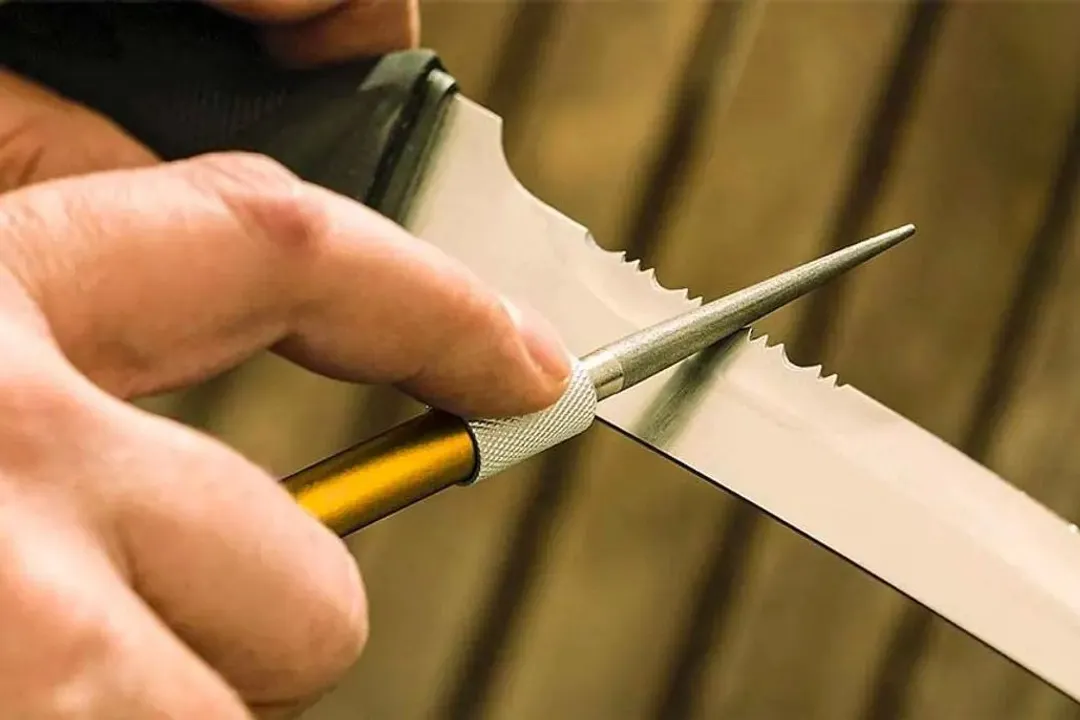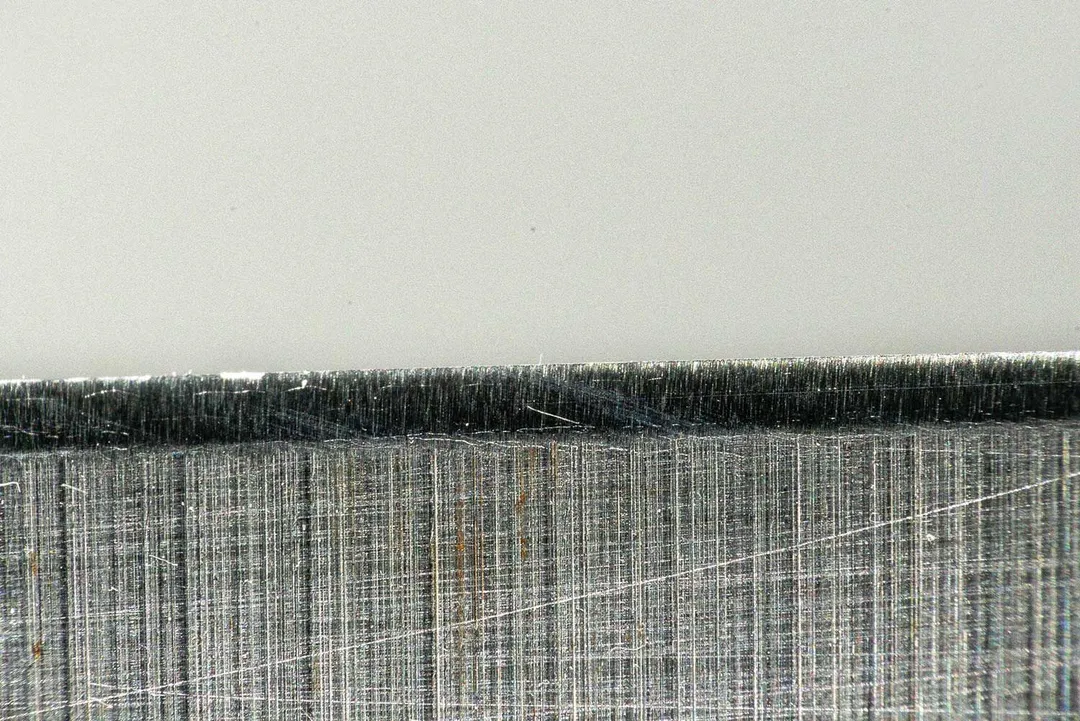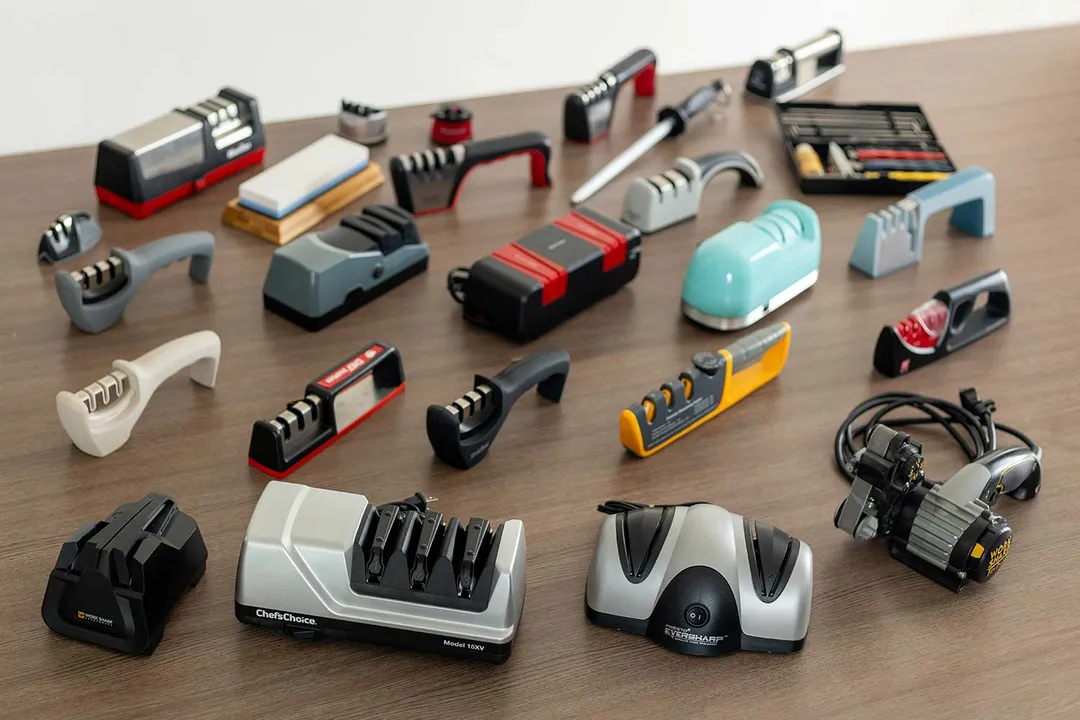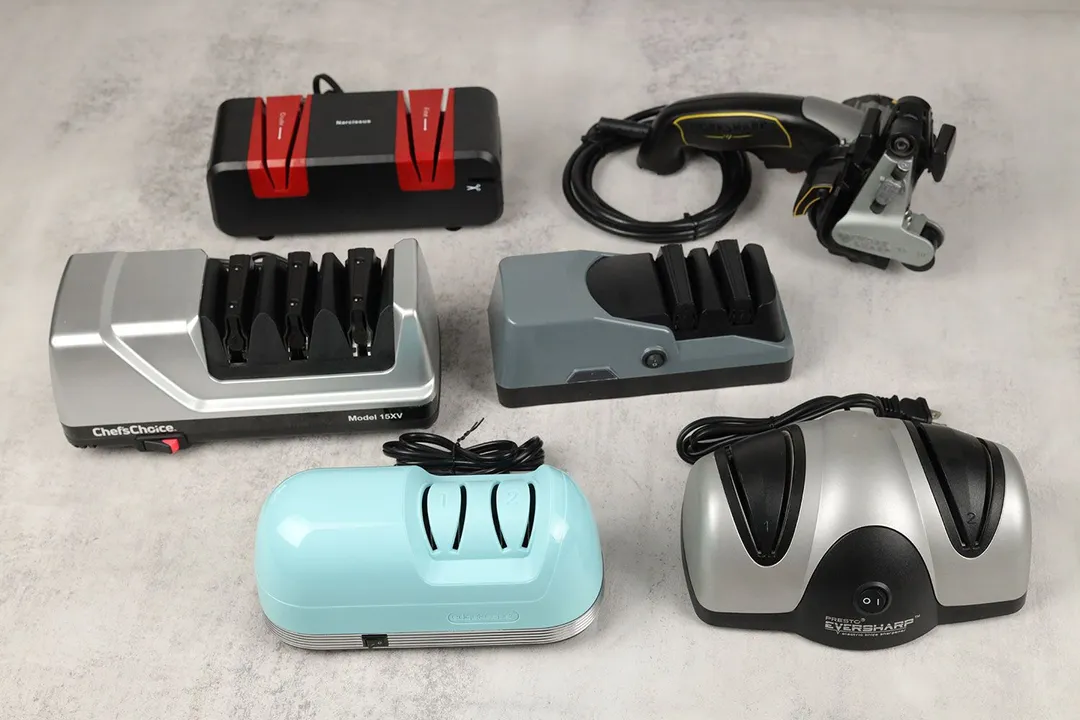Our recommendations are made independently through Research & Testing. We may receive commissions from purchases made via our links.
How to Sharpen a Serrated Knife
Have you ever wondered how to sharpen a serrated knife? It’s not as easy as other blades, but you can restore your bread knife’s edge.Have you ever wondered how to sharpen a serrated knife? It’s not as easy as other blades, but you can restore your bread knife’s edge.
If you read us regularly you know there are many options to help sharpen your dull blades. But those are usually for the chef’s knife variety. One thing that is more rarely covered, both here on Healthy Kitchen 101 and elsewhere, is how to sharpen a serrated knife.

We’re all aware that serrated knives are often the best option when cutting bread, tomatoes, and a range of other foods. But why is that?
The points of the serrations concentrate your downward force onto a smaller cross-section of the food. They’ll pierce the outer surface (which is often tougher than the interior) easier that way. Then you can saw back and forth to expand those pinpricks.
So those points do a bit more work than the ‘valleys’ (known in official lingo as ‘gullets’) between them. As such, they take a bit more wear.
What wears the points down even more than that, though, is the flat surface you cut on. Once you get to the bottom of your bread loaf or steak, there’s a cutting board or a porcelain plate below. The points of your knife get dragged along that tough surface. Ceramics in particular can dull your edges very quickly.
With all this in mind, it’s clear the points are the parts that need sharpening the most.
Luckily, though, serrated knives are sort of magical. Since so much pressure is concentrated on tiny points, even dull points are pretty good at getting a cut started. After that, the sharper gullets can do more work, and the points will kind of ‘tear’ the material. A dull serrated knife is much more effective than a dull straight-edge knife.
Eventually, though, every knife edge needs some attention.
Can You Sharpen a Serrated Knife?
Most knife sharpening methods are made for straight edges. You run the bevel of your knife across a whetstone or pull it through a V-shaped sharpening notch. But those won’t ‘cut it’ for serrated knives. Occasionally you’ll find an electric pull-through sharpener with a flexible stropping wheel which can at least hone minor imperfections, but that’s not a complete solution either.
Sharpening the more complex shape of serrations takes more time and patience, but it is certainly doable.
The main thing you need is a sharpening rod. To do the job right you’ll want a ceramic or diamond-abrasive rod rather than merely a steel honing rod. Honing steel doesn’t actually remove material from the blade. The ceramic rods will have at least a bit of abrasive material to do the job right and diamond abrasives cut through the metal a bit faster.
Ideally, you want to find a rod with the same curvature as the serration gullets or one that tappers on one end. A few sharpener sets even have angle guides to take some of the guesswork out.
How Do You Sharpen a Serrated Knife?
This can be a tedious process, so set aside some time for it. Fortunately, you don’t have to sharpen serrated knives often. And since most serrated knives are beveled on only one side, you really only need to focus on that side.
What you need
- A dull serrated knife
- A sharpening rod
Instructions
- Hold the knife with the edge pointing away from you and the bevel side up.
- Place the sharpening rod in the first serration gullet. Ensure you hold it at the same angle as the bevel. Finding the correct angle is easier with serrated knives than straight-edge ones— the curvature of the gullet gives you more visual cues.
- Push the full length of the rod along the gullet while maintaining that bevel angle.
- Reset the rod and push it through several more times. A short sharpening rod will require more passes than a long one.
- Move to the next serration gullet and repeat. The process takes a long time because you have to do each serration individually.
- Once you’ve finished all the serrations, flip the knife over to the flat (unbeveled) side. The edge should have a burr of material that was scraped from the edge but hasn’t quite fallen off yet. Align that side of the knife on the sharpening rod with almost no angle and give it just one or two swipes along the blade’s entire length to remove the burr. If you prefer, this step can also be done with a fine-grit whetstone.
- Rinse your newly sharpened blade and let your tomatoes know they have something to fear again!

How to Sharpen a Serrated Bread Knife
Bread knives tend to have wider serrations than most other serrated knives. That means you’ll want a larger diameter sharpening rod. Fortunately, ceramic rods typically aren’t very expensive, so it shouldn’t break the bank.
As a bonus, large-diameter sharpening rods are usually longer than narrow ones, so you won’t need to do as many passes on each serration.
In addition to the occasional sharpening as outlined above, it can be a good idea to hone your bread knife every once in a while. This can be done almost as quickly as with a straight edge knife. Just run the length of the blade across your honing rod a few times. It will mainly be the serration tips that get attention that way, but they’re the parts that need honing anyway.
How to Sharpen Serrated Steak Knife
Steak knives are the ones most likely to dull quickly. If your steaks are particularly tender, you may not notice for a while, but all that contact with porcelain plates will do a number on the serration points.
These knives come with a wide range of serration sizes, so do your best to find the right size rod. Then sit down with a good movie and work your way through the knife set.
It’s worth noting that steak knives with super-tiny serrations probably can’t be helped much. You can try running them through an electric sharpener to remove the serration entirely. On the whole, we tend not to recommend tiny serrations specifically because they can’t be properly sharpened.
About your tip
Luna Regina is an accomplished writer and author who dedicates her career to empowering home cooks and making cooking effortless for everyone. She is the founder of HealthyKitchen101.com and HealthyRecipes101.com, where she works with her team to develop easy, nutritious recipes and help aspiring cooks choose the right kitchen appliances.
Anh Ngo is a writer with 9 years experience at different media outlets, covering from public news and events to product testing and analysis. At HealthyKitchen101, she works across different departments, communicating closely with its network of writers, editors, and health, tech, and search engine experts to provide a meaningful and pleasant reading experience for visitors.







